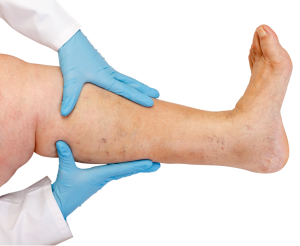
VENOUS ULCERS
This is the long-term complication of venous disease you want to avoid. It is a serious cause of disability, time off work, and interruption of normal activities. A venous ulcer is a breakdown of the skin, usually occurring at the inner ankle, that refuses to heal, or heals very slowly. It is a consequence of prolonged abnormal vein pressure as a result of vein valve dysfunction. What does that mean?
The leg veins return blood to the heart. When sitting or standing, the blood has to move up the leg against the force of gravity. The mechanism of moving the blood in the veins is complex, but dependent on the presence of one-way valves located about every 2-4 inches up the vein. Thin valve cusps open to allow blood flow up, but snap shut to prevent pooling of blood down the leg. If the valves don’t function, the pooling blood creates higher pressure in the veins because of gravity. Of course, this pressure is “felt” below the failed valves, and the pressure is higher and higher in the vein segments further and further down the leg – the higher the column of blood, the higher the pressure. This back pressure is expressed down the abnormal vein and out to the surface veins and the skin. So, this is where varicose veins come from. But, there is also a long-term effect on the skin. It can develop swelling and stiffness. There is deposition of blood pigments in the skin as a result of the back pressure forcing blood cells through the capillary walls. The entire health of the skin deteriorates. And if it is even slightly damaged, it does not have the integrity to heal. Thus starts a chronic wound or ulcer. Often, a small scratch will fail to heal, but the process then involves the edges of the wound, and it grows and grows, sometimes resulting in a wound the size of your hand.
Venous ulcers require a two-pronged approach to treatment. The ulcer wound requires appropriate care. If it is mistaken for another kind of ulcer, local care may not be appropriate. Sometimes antibiotics are helpful in the healing of these wounds. But the wounds won’t heal unless the abnormal back pressure in the veins is countered. This can be done with compression stockings or well-performed compression bandaging. But in the long run, it is best to identify and treat the underlying vein disease. This may involve treating the Great Saphenous Vein with the Closure procedure (endovenous radiofrequency ablation) or other veins with endovenous chemical ablation (see Diagnosis and Treatment of Varicose Veins). In some cases, the deep veins of the leg are abnormal, and diagnosis and treatment can be quite complicated. Most physicians have been taught that venous ulcers are nearly always a result of previous deep vein thrombosis (blood clots), and usually can only be treated by life-time use of compression stockings. What we now know, and what I see in my practice, is that most patients with venous ulcers have disease of the superficial veins as the cause of their ulcer, and can be effectively treated after proper diagnosis. So, while venous ulcer is often thought to be a complication of deep vein disease, it is essential to have an expert evaluation with ultrasound of both the deep and superficial vein systems.
Appropriate treatment with the latest minimally invasive techniques can provide rapid, long-term healing of the ulcers, and even reversal of the skin changes.
